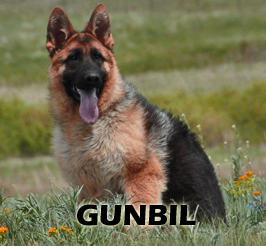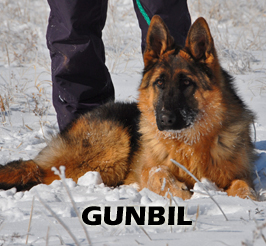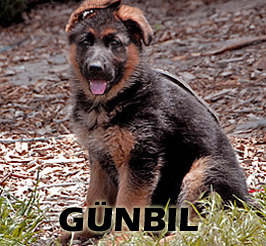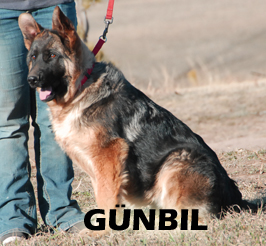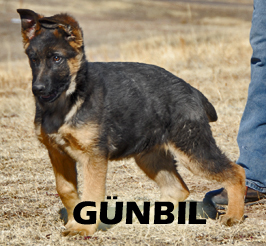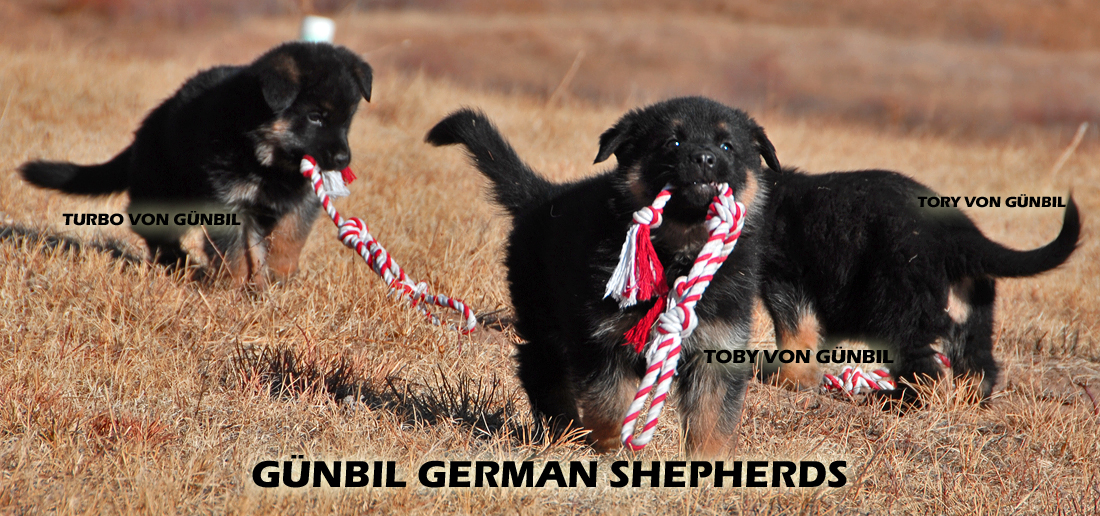
Pick of the litter (Picking the puppy that is right for you)
The "Pick of the Litter" is very important in determining what type of dog your looking for and what purpose the dog will serve for you and/or your family?
Those with some knowledge most likely know that it means "the first pick puppy", it does not however mean the best puppy in the litter for YOU.
At Gunbil German shepherds, we understands that not every dog is right for every family, AND not every family is right for every dog. It is BEST if you choose the dog that best compliments your life and your families life.
Dogs are pack animals. Please be certain and consider wisely for what purpose will your dog have in his new home and environment. If you are not looking to show your German shepherd dog or use him/her in your breeding program then your chances are far better in choosing the right puppy that best fits your needs and your lifestyle, this would be the PICK puppy for you and the best puppy as well.
A Family Pet: The German shepherd makes a wonderful pet that will be a great addition to your family. They are a very affectionate loving dog and, if raised with children, make an excellent playmate as well as watchdog for them. If you get your German shepherd as a puppy for your family, the bond between him and you will grow all his life; you and your family will be considered his family, and he will act as such. A family pet may be the one who is most laid back, does not lack confident with an excellent "sound" temperament and the natural ability and instinct to protect his/her family . The Alpha DOG is NOT recommended for you. Please read below the family pet characteristic and behavior profile.
- Medium level of Play Drive: This is the desire to have physical contact with the handler, family, or even other dogs. This behavior is mostly seen is younger dogs but can follow a dog through life. If a dog is properly socialized as a pup it will retain this quality well into adulthood. You can usually tell when two dogs are about to play by a specific signal that they use. It’s called Beckhov’s bow. Once a dog bows and the other accepts, the rank order is put aside and this allows for aggressive play that is understood by both parties to be just play. This drive can be used for motivating many forms of training.
- Medium level of Prey Drive: This is the desire to chase, grasp and subdue prey. This is one of the most over used and misunderstood terms in dog training. It is often interchanged with the term play drive. Nothing could be further from the truth. In its purist form the object of prey drive is a kill. In prey drive a dog becomes target-locked (fixated) on a moving object. Its body will become fluid and reactive with its total and complete attention on the prey item. The dog will lower its center of gravity and bring its tail into the plane of its spine for better balance. Its ears will turn towards the prey object like radar and its eyes will be wide open and in a receiving mode. Prey drive is a silent drive. Barking dogs don’t sneak up on things very well, however, it is not uncommon for a very frustrated dog to vocalize if restrained too long or too often in training. Once the dog gets to the prey it grasps it any way it can and as soon as it feels the advantage it will try to get a better purchase on the prey by adjusting the grip inward. When the prey goes down there is often one more grip adjustment and then the dog often shakes the prey. This drive is a critical drive for a patrol dog because it can motivate many of the dog’s criminal apprehension skills.
- Medium level of Rank Drive: This is the desire in the dog to raise his stature within the pack. A dog that has a high rank drive will try to work his way into the alpha position. The term alpha is a relative term. In any group of dogs one of them will be the alpha. That is the dog within that group with the highest rank drive combined with the most physical prowess. You could take that dog and put him in a group with dog’s that have yet even higher rank drive and he would not be alpha. Dogs with high rank drive are prone to trying to dominate every dog they come in contact with. They will have a tendency to fight for this dominance. A rank dog will also challenge the authority of the handler. This will most likely occur during corrections or when the dog feels it is being forced to do something against its will, especially the down command. The behavior will manifest itself as growling, snapping and even biting the handler when the handler presses these issues. The strange thing is that a dog can have fairly high levels of both a rank and subordinate drive. These dogs are driven to lead but willing to follow if a stronger leader is available.
- Medium to high level of Pack Drive: This is the desire to have social contact with the pack members. It is the mental aspect of the social drives. The dog seeks the company of others. This dog wants to hang out with anybody, other dogs, other people, and especially its handler. In higher levels this dog would follow you everywhere, be underfoot constantly, even waiting outside the bathroom door.
- High level of Protection Drive: This is the drive to defend the pack leader and other members of the pack. This drive is seen when either a real or imagined threat is perceived. A subtle sign of it is when a dog moves between its handler and a stranger and then remains alert. An extreme example would be a dog engaging a threatening individual without ever having had any protection training. This drive is much more rare than people think.
- Low Level of Activity Drive - This is the impulse to be constantly active. Not hyperactive, just on the go all the time. Although the drive is mental the manifestation of it is physical. Activity drive puts energy into all other drives. A dog with a high activity level will usually be trying to entertain itself. This can become problematic if the dog doesn’t have a constructive outlet for all that energy.
A Show Dog: A Show line German shepherd competition quality dog must have balanced temperament, with show conformation and breed standards on both parents. The puppy must possess strong character and powerful drive. Alert and willing to please attitude.
- The German shepherds show lines recognized by the FCI are absolutley consistent in "SHOW" type. Show line German Shepherds tend to be larger, more angulated and brighter in color than Working Line dogs. They are predominantly black and red and exhibit a fluid trot and sound temperament which is usually softer than that of Working Bloodline German Shepherds.
- If you're planning on showing your puppy/dog, please let us know this is your option and you may show your dog at anytime but we do recommend if you're wanting a dog for show, PLEASE specify to us so we can pick the "correct Drive Characteristics and Behavior Drive" for this purpose.
A Breeding Quality Puppy: A breeding quality dog should have an excellent pedigree with dam and sire in the champion position, titled and show ranked (preferred). The over-all genetics should have excellent health record, with excellent breed value (Zught). As a "Show Puppy", they should have confident character, with extreme drives, positive aggression and superior sound temperament with "SAFE" in nature Character. The parents should be within the breed standards with rich pigments (even at an older age).
- The grand parent are the key in breeding super dogs. Obviously, you would want to know who the grandparents are as-well.
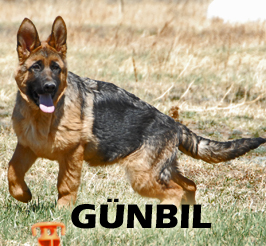
- All About German Shepherd Puppies
- Pet Disease and Allergies
- Hips and Elbows
- German Shepherd Dog Anatomy
- What is Schutzhund
- German Shepherd Behavior
- Quick Tips On German Shepherds
- Our Show Dogs
